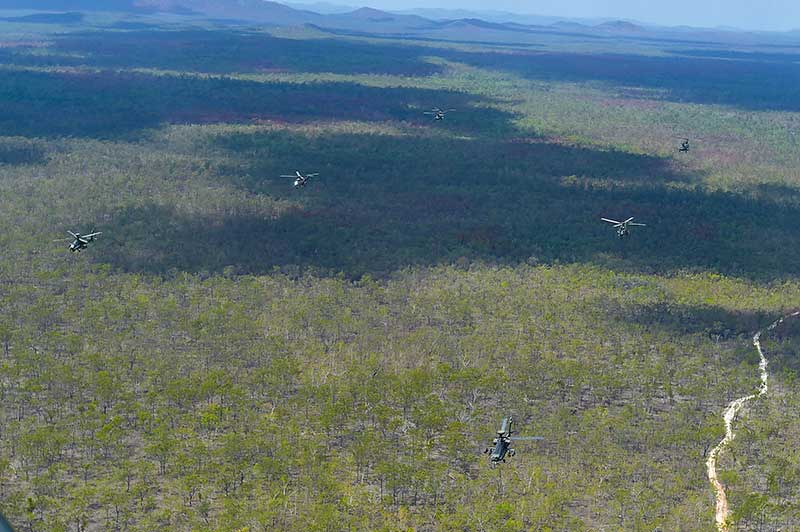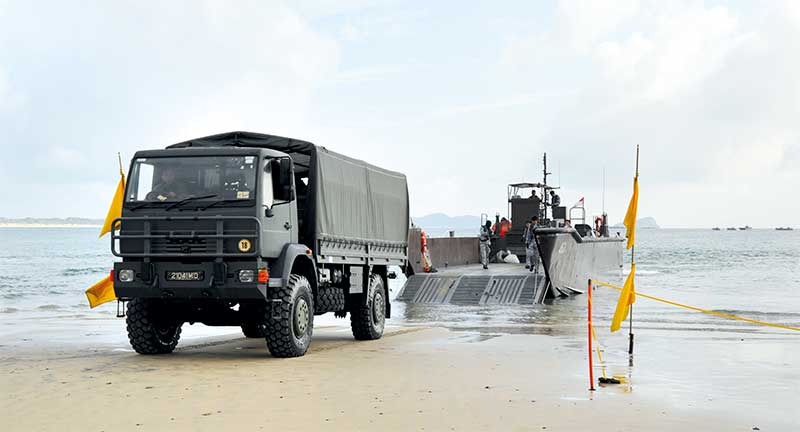OPS & TRAINING
TRAINING DOWN UNDER
01 Dec 2017
In its 27th year, Exercise Wallaby 2017 continues to enhance interoperability among the Army, Navy and Air Force through training sessions such as air-land integrated live firing.
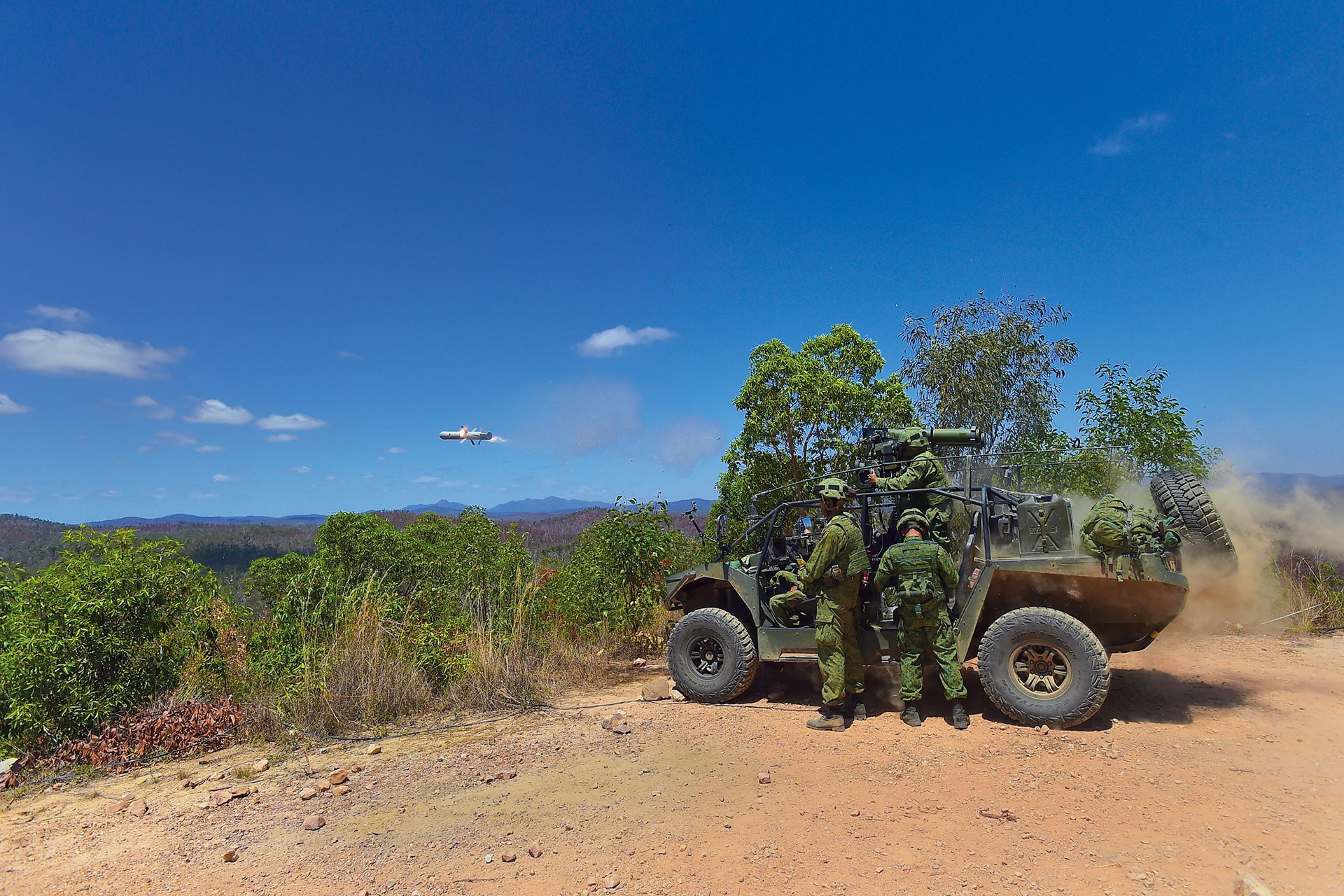
Two Light Strike Vehicle Mark IIs (LSVs Mk IIs) lie in wait under the cover of vegetation for an opportunity to strike two "enemy" clusters.
Everyone holds their breath for the command to fire as the gunners make the final adjustments to their aim.
Fire! The sound is deafening as the SPIKE Anti-Tank Guided Missiles and the Automated Grenade Launcher fire in quick succession at the enemy.
On cue, two Apache helicopters, armed with missiles and machine guns, emerge from the cover of the foliage and unleash their arsenal upon the fleeing enemy troops.
As the smoke clears, the soldiers quickly scan the horizon for enemy troop movements. They turn around and give the "all-clear" signal. Mission accomplished.
VAST SPACE
Held from 3 Sep to 4 Nov at Shoalwater Bay Training Area (SWBTA) in Queensland, Australia, Exercise Wallaby 2017 involved about 4,000 Singapore Armed Forces (SAF) personnel and over 400 platforms from the three Services.
The vast training space there allows the SAF to conduct realistic training, such as the air-land integrated live firing described above.
During his visit to SWBTA on 9 Oct, 2nd Minister for Defence Ong Ye Kung expressed his appreciation for the use of SWBTA. "Exercise Wallaby is one of our most important overseas exercises. The wide span of space available allows us to conduct training at a scale, scope and complexity that is not possible in Singapore or anywhere else."
INTEGRATED TRAINING
Grateful for the opportunity to train in SWBTA, which has an area about four times the size of Singapore, Exercise Director Brigadier-General Mark Tan said: "As the SAF grows in complexity and evolves over time, training the soldiers from different Services to fight together as one is very important.
"The SWBTA allows us to carry out air, land and sea training concurrently; it is a unique training area where soldiers can enhance their interoperability across the Services."
While realistic training was important, the safety of soldiers was also a key priority, said Exercise Air Director Senior Lieutenant Colonel Sherman Ong. He noted that there were already various safety precautions in place, such as conducting pre-mission briefs on possible safety hazards.
He added: "With so many air and land personnel who have been in past editions of Exercise Wallaby, we believe that they are the best channel to pass on these safety messages and guide the following batches of exercise participants."
BROTHERS IN ARMS
The tough training also forged bonds between the soldiers. Said SSG Kesavan: "The open and vast terrain in SWBTA meant that we have to be tactical while moving from one point to another, such as keeping low to the ground, and lowering our noise level, so as to avoid being detected by the enemy forces. Also, we had to climb up many more knolls here which made training much more tiring than back home."
He added: "I can never forget how we pulled one another up the knolls and encouraged one another to just keep moving and complete the task at hand." The most memorable moment in Exercise Wallaby for SSG Kesavan? The training held at the Urban Operations Training Facilities in SWBTA, where, together with personnel from other companies, SSG Kesavan and his men had to clear and secure a building in the training area.
SSG Kesavan recalled charging towards the point with his fellow Guardsmen. "No matter what company or rank we were, everyone was providing cover fire for one another. I felt as if everyone was my brother and no matter what happened, we'd always have one another's back."
COMING TOGETHER
Like SSG Kesavan, Task Group Operations Officer Major (MAJ) Lim Jun Qiang met with a multitude of challenges in coordinating the Navy's component of Exercise Wallaby 2017, especially when it involved about 10 units across all three Services.
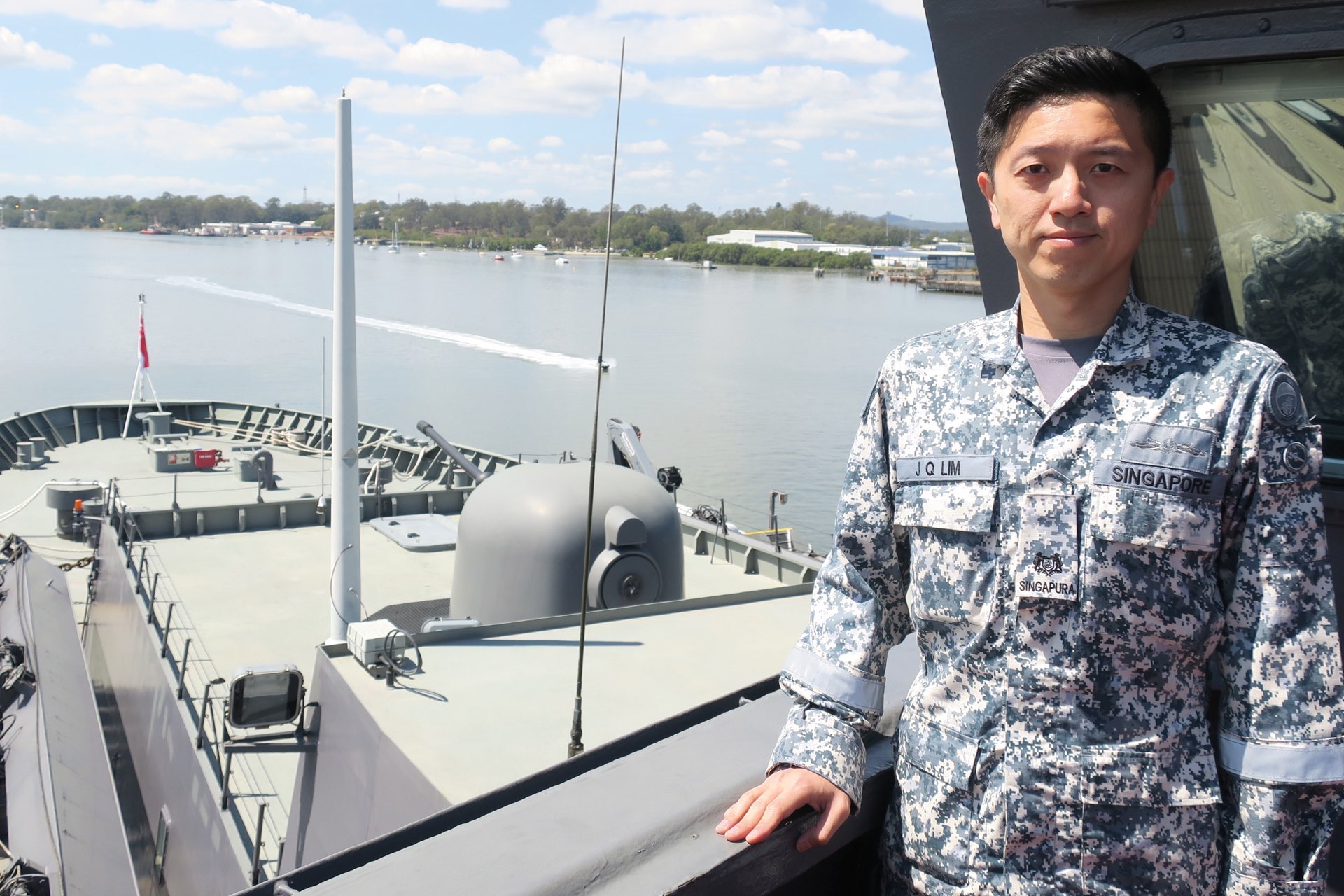
The Head of Operation Planning and Training Section, HQ 3rd Flotilla recalled that disagreements were common during the first few coordination meetings as different units had different requirements and training objectives.
"But as the exercise progressed, each unit started to see the exercise from the other parties' points of view... In the end, all the units offered assistance to one another. This can only happen when we stop thinking that we are three separate Services, and as One SAF instead."
Involving Landing Ship Tank RSS Resolution, five Fast Craft Equipment Personnel and four Fast Craft Utility, the Navy's component of the exercise was split into two phases where amphibious operations up to a battalion-sized Task Force and ship-to-shore training - which included the beach landing of vehicles - were conducted in an unfamiliar environment.
The first phase focused on training the individual to ensure that each possessed a basic proficiency level, while the second phase brought them together to build teamwork in tactical execution. During the course of the exercise, Navy personnel had to deal with high surf conditions, strong tidal streams and daily temperature extremes while doing their best to hone their navigation and seamanship skills.
To overcome these challenges, the exercise was designed so that people were progressively introduced to the new environment. "In addition, we also made sure that each soldier was adequately skilled in his respective tasks before bringing the whole team together to execute more complex missions, such as the beach-landing of the 5-tonner."
WORKING AS A TEAM
As the Deputy Chief Planner of 127 Squadron, MAJ Vivek Nair was also the team lead for a heliborne mission that involved six helicopters from the Republic of Singapore Air Force - two Chinooks, two Apaches and two AS332 Super Pumas.
This mission is a means of large-scale troop transportation which can involve up to eight helicopters to transport a maximum of 300 troops in one trip.
Assets that are more susceptible to enemy attacks will also travel in the middle of the formation and be escorted by the helicopters.
Besides providing firepower, the Apaches help to ensure that the landing site is clear of enemy forces and thus safe for landing. On the other hand, the Chinooks and Super Pumas provide greater carrying capacity so that vehicles and loads, such as oil drums and ammunition, can be underslung to resupply the troops.
"One of the main challenges faced during the large-force transportation is the sheer number of aircraft being airborne at the same time, so we have to make sure that there is a safe distance between each aircraft," said the Chinook pilot.
"The helicopters were also not able to travel quickly (with their loads)…so we have to plan the route properly to ensure that we have sufficient coverage and concealment."
MAJ Vivek was proud of the crew's hard work.
"I'm heartened to see that they constantly put in their all to execute the missions to the best of their abilities and take each training seriously. "I'm sure they've all benefitted from the very realistic training environment in SWBTA and have grown to be better pilots."
MR ONG VISITS EXERCISE WALLABY
During his visit to Australia from 7 to 12 Oct at the invitation of Australian Minister for Foreign Affairs Julie Bishop, 2nd Minister for Defence Ong Ye Kung visited the Shoalwater Bay Training Area to catch airmen and soldiers from the Republic of Singapore Air Force (RSAF) and Singapore Army in action on 9 Oct.
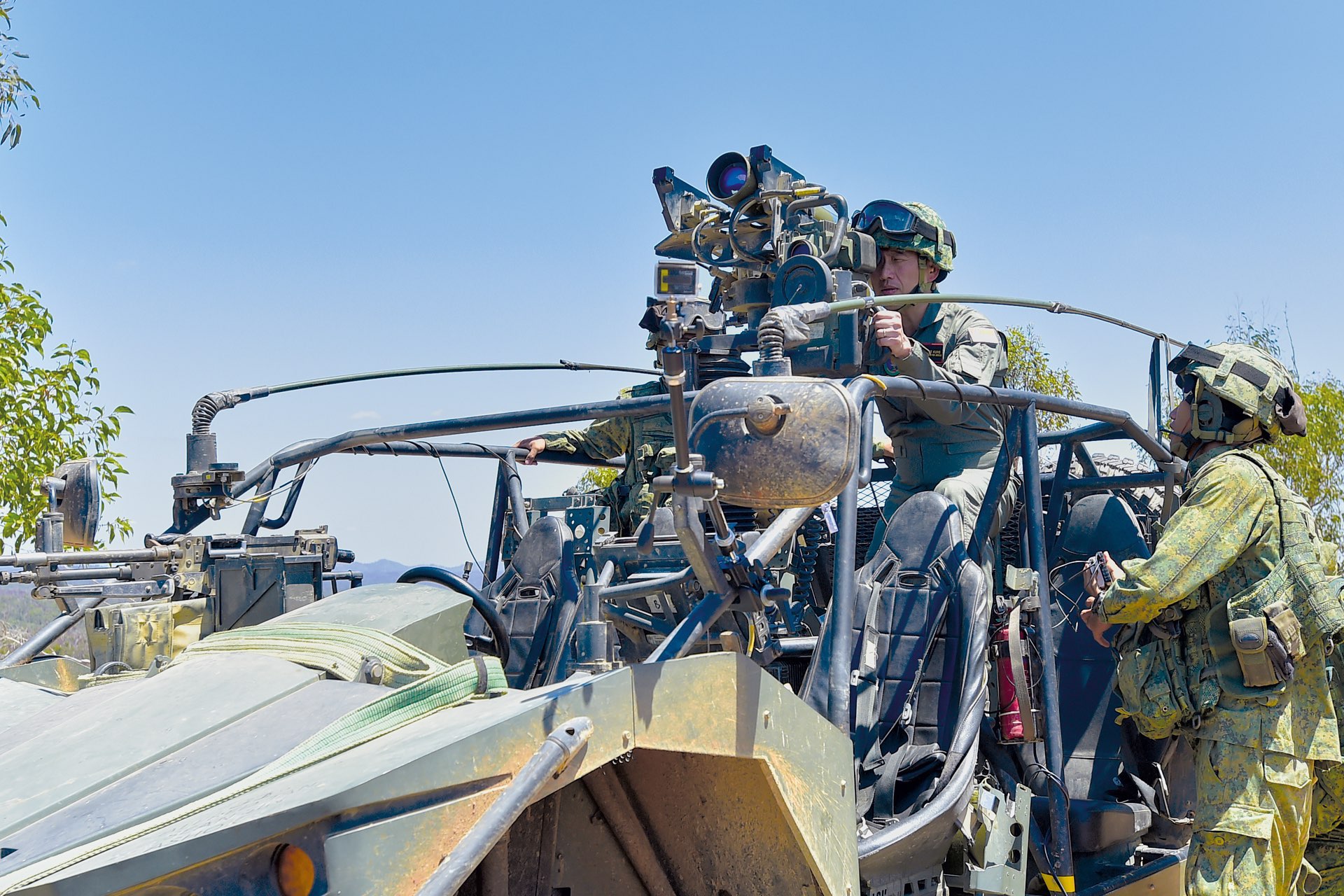
Mr Ong saw the air-land integrated live firing which involved the RSAF's AH-64D Apache Attack Helicopter, the Army's Light Strike Vehicle Mark II (LSV Mk II) and the SPIKE 2 Anti-Tank Guided Missiles (ATGM).
He also fired the SPIKE 2 ATGM himself, drove the LSV Mk II and rode on the Bionix Infantry Fighting Vehicle.
As part of his trip to Australia, Mr Ong also met Australian Minister for Defence Marise Payne in Sydney. The two leaders reaffirmed the long-standing defence ties between both countries and discussed regional and global issues of mutual interest.
ALSO READ IN OPS & TRAINING

Exercise Wallaby 2025: To see better, shoot faster
31 Oct 2025
The SAF focuses on complex strike missions and multi-domain integration in Exercise Wallaby 2025, the 35th edition of its largest unilateral overseas exercise.

Ex Wallaby 25 – Greater Integration and Complexity
25 Oct 2025
The 35th edition of the SAF’s largest unilateral overseas exercise is an opportunity for expanded scale and deeper integration towards an effective, networked fighting force.

Ex Forging Sabre ramps up use of unmanned assets in integrated strike operations
12 Sep 2025
In this 10th edition of Exercise Forging Sabre, the SAF sharpened its cutting edge for the dynamic modern battlefield, with expanded integration between manned and unmanned platforms.

